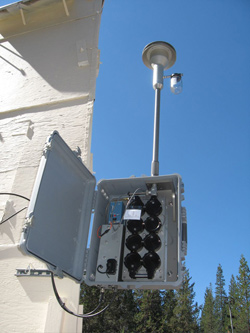Do pollutants from Asia affect California’s climate?
Why is there soot on the snowpack?
New air sampling stations in Sierra Nevada will search for pollution sources
Massie Santos Ballon, special to mongabay.com
May 22, 2008
|
|
This fall, suitcase-sized air samplers will sprout throughout the Sierra Nevada.
The air monitoring stations will be installed by researchers at the University of California, Davis, as part of a contract approved by the California Energy Commission (CEC) during its May 7 meeting.
The researchers hope to learn whether the pollutants affecting the state’s climate are coming from local sources or from transPacific sources like Asia, said Public Interest Energy Research (PIER) manager Guido Franco. The sensitive new devices will measure the amount of air pollution in the area and identify the makeup of the particles, Franco told the commission. Chemical detective work will then reveal their sources.
“Previously funded PIER research has found that particles in the air in California may be reducing the snowpack in the Sierra Nevada,” Franco said. “The solid particles, in this case black carbon, are changing the reflectivity of the snow, contributing perhaps to the already observed melting of the snow.”
CEC chair Jackalyne Pfannenstiel asked Franco how identifying the sources of the air pollution would contribute to understanding how the state’s climate is changing.
|
|
“If it is black carbon that originates from Asia, I think we don’t have the authority — as far as I know — to control these emissions,” he replied. “But if the main source of the carbon originated here in California, then there may be some regulatory policies that we can use to reduce those emissions.”
Previous studies have documented that dust from Asia — especially from deserts and industrial regions of China — routinely crosses the Pacific Ocean on prevailing winds to sully the air over the western U.S. However, there is no direct link between air pollution coming from Asia and this year’s Sierra snowpack being below normal, Franco told Mongabay.com. “This is a hypothesis at this time,” he said. “The data will give us some ideas about the timing of the transport from Asia or from other sources, but more studies will be needed.”
Steven Cliff, the UC Davis atmospheric scientist who wrote the approved proposal, agreed with Franco. “Simplistically, if I put soot on top of snow, one might think it would melt more quickly,” he told Mongabay.com. “In terms of why we have less snow, it’s because we got all of our precipitation really early [this winter].”
For Cliff, the air monitoring stations will provide data not just about the state’s air quality, but more importantly, how air pollution impacts the state’s climate.
Several of these specially designed 8-drum air samplers already collect data from locations on Mount Tamalpais, Lassen Peak, and the Donner Summit. Each drum collects particles within a specified size range for a three-hour period, spread out over six weeks. Scientists then “fingerprint” the particles using a technique called x-ray fluorescence, and then identify their sources using atmospheric models and satellite images.
The existing sampling sites were chosen so researchers could study how far pollutants can travel, Cliff told Mongabay.com. Sampling at higher elevations would allow the team to analyze a part of the atmosphere where local pollutants typically don’t reach. It turns out that the Donner Summit site samples have more pollutants from sources such as residential areas, Interstate 80, and the trains than had been expected. Still, Cliff said, they’ll likely keep the site and add a new location elsewhere that will meet the original requirements.
Existing data also indicates that the pollution from across the Pacific is cyclical. “Spring is more typically dominated by dust from Asia. But other pollution like sulfates and black carbon can come at any time of the year,” Cliff said. For example, about two-thirds of the particle pollution at Lassen Peak in the spring comes from Asian sources, he noted.
Cliff expects to see higher levels of pollution from the new Sierra Nevada samplers. He expects results to confirm or disprove his hypothesis by next spring, at the earliest.
“What I know is that pollution levels in Asia don’t appear to be dropping. And more sources of pollution are continually being constructed [there],” he said. The only way to gauge the effects on California, he added, is to monitor the pollution levels continually and over a long period.
Massie Santos Ballon is a graduate student in the Science Communication Program at the University of California, Santa Cruz.
